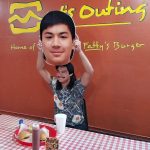
By Destiny Castaneda
Every Monday evening communications student Courtney Kaiser makes a 45-minute to an hour drive from where she works in San Antonio’s northern Stone Oak area to her class on the far South Side. Exhausted and rushing to class in her black work scrubs, she says she never has time to fit in a nutritious meal. If she does, it is on the hour drive home to Fredericksburg.
“Not only is Monday the worst day for me, I never fail to get stuck in traffic,” Kaiser said.
Many students do not have the time to sit down and have a healthy and nutritious meal throughout the day due to their busy schedules. The quick Snickers bar and soda from the vending machine gives just enough energy to make it through that long lecture.
At Texas A&M-San Antonio, there is only one food service area located in the Central Academic Building. According to Cristina Martinez, director of dining services, the café tries to have a variety of foods to accommodate all students and faculty.
“We try to portion our food so that no one is eating more than they should in one serving,” Martinez said. “But there are also some students who want that extra side of fries or Frito pie because they haven’t eaten anything that day.”
The cafeteria has a variety of healthy choices including the salad bar, grilled chicken sandwiches, and chicken wraps. It also has quick grab-and-go snacks like fruit, yogurt and veggie sticks.
But what about those students who have an evening class after the cafeteria closes at 7 p.m.?
Students in evening classes say they tend to use the vending machines more often than students enrolled in earlier classes. Because they have not eaten a full meal, some students say they feel as though they aren’t as engaged in class activities.
Kinesiology assistant professor Liset Vasquez said bad diets contribute to poor health and can lead to diabetes.
“Healthy eating is very important to prevent diabetes, which is very common in this community,” said Vasquez, who is also a Certified Health Education Specialist and Registered and Licensed Dietitian. Vasquez is currently developing a Bachelor of Science degree in health with a focus on community health.
Vasquez recommends the following tips for students to consider on a daily basis:
- Exercise 30 minutes daily
- Eat plenty of fruit and vegetables
- Stay away from sugary drinks. Drink water and plenty of it!
- Eat nutrient rich and fat free foods. Whole grains give you energy.
Although it’s a struggle, not all students are affected by lack of nutrition. Kinesiology senior Edward Moreno says he makes healthy eating one of his main priorities.
“Now that I am in my last semester here at Texas A&M-San Antonio, I have made sure that I stay on a healthy diet,” Moreno said. “I have a full-time school and work schedule and it’s easy just to eat junk food. But in order for me to focus, I have to stick to the healthy foods that give me energy.”
Healthy eating can make the difference between having a sluggish and negative day to a positive and productive one. Many students like Courtney Kaiser drive long ways from work and home to come get an education.
“I’m so exhausted I just want to hurry up and get home to sleep,” Kaiser said. “Seventy-five percent of the time I just want to skip my dinner.”
The drive from work or that busy schedule that keeps students from having a balanced diet could be the difference in test scores or staying awake in that evening lecture class.






